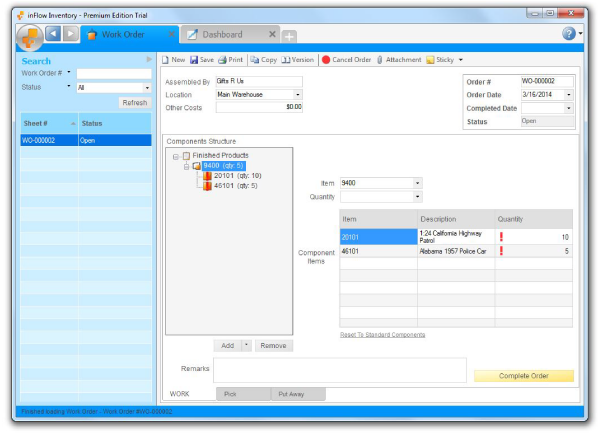Work orders are an essential part of internal communications for a manufacturing environment. It tells your operations that a customer has purchased your products and that you’ve been given the green light to start production.
Work orders are used in a traditional manufacturing business: a business that puts together combination packages, and/or a business that converts products into a completely different item altogether. Regardless of the type of manufacturing environment you are in, below you’ll find some resources including work order forms, and software to make the manufacturing process easier.
What is a work order?
A work order is essentially a customer sales order, but with job details and assembly instructions. It is a recipe book for the shop floor, telling the manufacturer the exact quantities of raw materials needed, and costs for building or assembling a product.
In many cases, work orders are handwritten paper forms distributed to the shop floor. Once a work order is received, assembly can begin provided that all the inventory parts are in stock. If items are missing from the work list, then the parts will need to be purchased. These delays can push out delivery deadlines and increase the days outstanding in receivables.
Work orders are a tool to help your operations with planning and scheduling. It provides you the ability to:
• Forecast demand so you know how much inventory to keep on hand;
• Plan your staffing needs according to production dates; and
• Run a leaner operation – not over staffing or holding too much stock.
Work Order Form
Work order forms are traditionally created in Excel inventory template spreadsheets, Word documents or in an Access database. It eliminates the need to hand-write each work order out. However, static forms (Excel, Word or Access) still require manual data entry for each new work order. This can be time-consuming and can be littered with human error. If you happen to have a lot of similar products, the chances of errors increases. For instance, if your products are made up of various components like a bicycle, it is very easy to create a work order with more expensive components than what your customer had purchased. This error will lead to a loss in both revenue and parts.
However, static forms (Excel, Word or Access) still require manual data entry for each new work order. This can be time-consuming and can be littered with human error. If you happen to have a lot of similar products, the chances of errors increases. For instance, if your products are made up of various components like a bicycle, it is very easy to create a work order with more expensive components than what your customer had purchased. This error will lead to a loss in both revenue and parts.
Why use a work order system?
A work order software system saves you time by getting rid of double-entering. The software will automatically convert a sales order into a work order. It will also source the right parts needed (bill of materials) to build the product for your customer, eliminating assembly errors. Additionally, it will provide you with forecasting data so you can plan for proper inventory levels to guarantee that you can meet future sales demands.
 Nothing is worse than telling a customer that their order will be delayed. This can jeopardize future repeat business and it sends red flags on the stability of your business. To make matters worse, it also increases the days outstanding in receivables so that means you are carrying the debt longer.
Nothing is worse than telling a customer that their order will be delayed. This can jeopardize future repeat business and it sends red flags on the stability of your business. To make matters worse, it also increases the days outstanding in receivables so that means you are carrying the debt longer.
Work order software
An inventory management software system will help automate your work orders so that you can meet the demands of your customer more easily. It will help you know what you have in stock so you don’t run out of inventory when you’re making products. If you run out, you can also create purchase orders in just a few clicks.
Best of all, you can try inFlow Inventory to manage your work order for free! First, download the free edition from the home page.
Next, inside the software you’ll see an upgrade menu option. Click it and you’ll instantly be able to try the premium edition which includes bills of materials and work orders.






Will inFlow initiate lower level work orders automatically or do I need to initiate work orders from the lowest level (first) and then move up the structure?
Hi Barry,
inFlow will create sub-assemblies as part of a larger work order, if required.
So if you need 2x wheels and 1x frame to make 1x bicycle, but you don’t have any wheels in stock at the moment, then inFlow will suggest a sub-assembly for 2x wheels as part of the work order for the 1x bicycle.
We’ve got a support article on work orders here, and it also has a video that can help to illustrate how the program treats work orders: https://www.inflowinventory.com/support/article/34458980/how-do-i-make-products-or-kits-out-of-raw-materials-using-a-work-order/